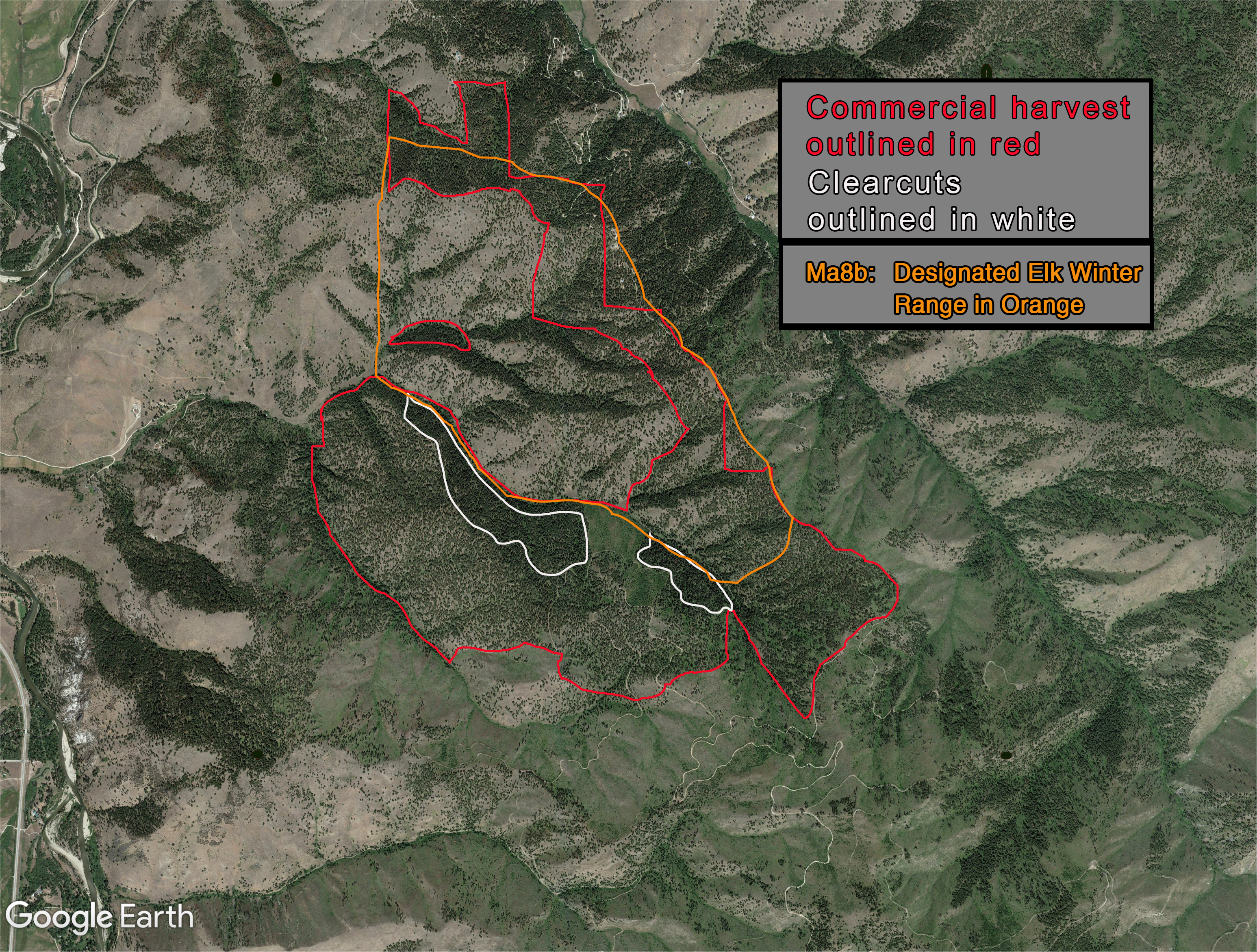Friends of the Bitterroot
filed a complaint against this timber sale 2/19/2020
After over a decade of attending field trips making comments and asking for changes to projects in order to uphold the Forest Plan, protect wildlife habitat, and preserve fisheries, we have no other recourse but to file a lawsuit against the Darby Lumber Land timber sale
See the Ravalli Republic Article (Please show your support by clicking the smiley face)
See the Missoula Current Article
See the issues below...
Darby Lumber Lands 2 Contract Sold
To the only bidder Pyramid Lumber at:
$60 a truckload of saw timber
A log truckload of just firewood would cost @ $1000
Darby Lumber Lands 2
Commercial Logging in Elk Winter Range
Large Clear Cuts
Illegal roads in areas reserved for Elk Winter Range
Don't Let the Bitterroot National Forest
Destroy Another Refuge for Elk and other Wildlife
Darby Lumber Lands 2 Project
The Issues
- Large Clear Cuts: Darby Lumber Lands 2 (DLL2) includes a 100 acre and a 39 acre clearcut. Clearcuts over 40 acres require 60 days of public comment. The DLL2 EA allows only 30 days. The two main purposes for these clearcuts are inconsistent with recent science and go against current forest service procedural manuals. Here are some articles discussing the Benefits of Mistletoe for the forest: http://rspb.royalsocietypublishing.org/content/279/1743/3853, Lack of regeneration in cleared areas due to climate change: https://www.eurekalert.org/pub_releases/2017-12/tuom-sfr121317.php Forest manuals recommend treating mistletoe ONLY when the focus is timber production. DLL2 is dominated by land preserved for Elk Winter Range: https://ufei.calpoly.edu/ForesTree/files/collected/dougfirdm.pdf Remedy: No clear cuts bigger than 20 acres and consider mistletoe treatment alternatives like creating islands etc.
- Forest Plan (FP) standards cannot be met by the proposed project prompting the FS to make multiple amendments to the Forest Plan due to damaging proposed “treatments” and overreach. Site-specific Forest Plan amendments are meant to address unique characteristics of a particular forest area, not conditions that are common throughout an entire forest or region. Due to widespread excessive road density on suitable timberlands, the BNF has used “site specific Forest Plan amendments” that wave the Elk Habitat Effectiveness (EHE) legal limitations for road density on 226,119 acres of BNF’s total of 389,820 acres suitable timberland (FP, p. III-2) in the last 12 years. EHE protects habitat for grizzly, lynx, wolverine, fisher et al. Modifying it to address only elk does not serve the purpose of the standard. Remedy: Adhere to EHE standards in the Forest Plan
- Economically unrealistic haul route: Hauling 20+ miles out of a Rye Creek just to reach Hwy 93 will be extremely costly to taxpayers, damaging to forest roads, and detrimental to nearby streams and to the quality of life of those homeowners living along the haul route. The FS fails to provide economic an analysis in the Environmental Assessment (EA), thus hiding the exorbitant costs. Remedy: Be more fiscally responsible and do controlled burns and moderate hand thinning in these areas to create a more resilient forest.
- The EA has insufficient environmental analysis for the project (soils, water, wildlife, etc) failure to use most recent, best available science to support their proposed actions/treatments & absent/lacking measurement indicators to demonstrate before and after net benefits of proposed treatments to support their effectiveness and validity. Remedy: Spend more time on analysis especially considering alternative methods to reach desired results. Analyze alternative specified road locations in MA2 rather than in MA8b.
- The project would force elk and other big game onto private lands, reducing hunting opportunities and affecting private landowners. Area is an island of un-roaded forest amidst disturbance by fire and heavy logging by Darby Lumber Lands. Remedy: Protect Elk Habitat by not logging in MA8b, and not clearcutting. Consider cutting only trees less than 16 inches in diameter. Consider not creating loop ATV routes in the area.
- The project unlawfully includes road building in a management area (MA8b) that contradicts the Forest Plan that directs lawful management of the area as Elk Winter Range More broadly, DLL2 is an island of mature forest, relatively intact ecologically, amidst a sea of over-logged and burned forest lands that should be left “as is” or only minimally managed or altered by the FS. As discussed in the Forest Plan, the area was identified as prime elk habitat and is meant to be managed primarily to protect that premium value. Remedy: NO logging or road building in MA8b. Analyze alternative specified road locations in MA2 rather than in MA8b.
- In an area with streams officially recognized as having impaired water quality not meeting Clean Water Act standards due to excessive sediments from roads the project proposes more road building at great taxpayer expense and to the detriment of water, fisheries, soils, wildlife. Remedy: Fix the existing roads without adding roads, skid roads, or temporary roads in the area.
- The project’s Purpose and Need are flawed and inconsistent with proposed treatments –the forest involved is mostly composed of widely spaced trees, and combined with the surrounding lands from the fires of 2000 presents low fire risk, contrary to FS claims. Remedy: Consider treatment of prescribed burning instead of thinning and clearcutting.
- Ignoring overriding issue of climate change and actually exacerbating its impact on our Forest. Remedy: Analyze current science concerning thinning and its relationship with beetles, fires, and disease. Preserve trees for carbon sequestration rather than sell them at taxpayer expense.
- ATV connector route in Lynx habitat. Remedy: Move the connector route or consider other loop routes outside of Lynx habitat.
- ATV routes in DLL2 were poorly built without sufficient drainage. Remedy: Build connector roads to BMPs using forest service personnel.

More on the EHE Site Specific Amendment
You can see from the map above that the project area is an island in a sea of Darby Lumber Lands clearcuts and roads.
We believe the Bitterroot National Forest is abusing a loophole and causing increased damage to elk habitat across the Forest by repeatedly moving the goalpost of legally required protections. Numerous recent logging projects have been inconsistent with the Forest Plan regarding legal protections of elk habitat, so the BNF keeps giving themselves free passes.
The BNF Forest Plan is a foundational management contract with public landowners. It lays out legal limits to ecological harm. We are asking a judge to decide if the BNF can waive legal protections of elk habitat, yet again. We are drawing a line at the Darby Lumber Land project area because it is an island of prime elk habitat surrounded by a sea of elk habitat destruction.
Darby Lumber Land is locally infamous for square mile checkerboard private land, clearcuts and extensive, destructive road network created by Darby Lumber Company. Soon after that ecological debacle, the “Burke Fire” raced through Darby Lumber Land clearcuts and road network sending up the plume of smoke that became an iconic image for the “Bitterroot Complex” Fires of 2000 . Post-fire debris flows from the logged over land followed quickly.
Now, the Bitterroot National Forest plans to add more clearcuts, and build more roads, with their Darby Lumber Land logging project, adding publicly funded elk habitat damage to decades of damage by the Darby Lumber Co.
Much of the logging is aimed at areas described in the BNF Forest Plan as “sparsely forested,” “major big game winter range” or “not suitable for timber production”
The Forest Plan recognized this land as prime elk habitat and gave it legal protections for elk habitat effectiveness (EHE) and hunter opportunity. This publicly accessible elk habitat is even more important now due to all the recent nearby Darby Lumber private Land destruction.
Nearby and adjacent to the imminent logging project area are large areas of private elk habitat not accessible to public hunting. Elk moving to the private ranch refuges, an existing problem in this area, would reduce public land elk hunting opportunity due to displacement.
The BNF claims stable or increasing numbers of elk on hunting districts mean they are maintaining hunter opportunity. This means little to the hunter when those elk are on inaccessible private ground.
Elk habitat destruction lasts a lot longer than a few hunting seasons. Many generations of elk will need to get by on less prime habitat.
The area of Darby Lumber Land logging project has exceptional wildlife values and very low timber values; it sold for $60/ truckload (@$6 a cord). The BNF says this timber sale project will lose over 800 thousand dollars, a taxpayer subsidy to timber industry private profits. We hope to conserve the public wildlife and hunter opportunity values.
